 |
A trip to Jordan |
 |
 |
A trip to Jordan |
 |
Our (Malcolm, Tracy, Kevin and Alison) visit to Jordan was in September 97 after the long (8 month) hot summer and as Jordan is a desert like land the place was pretty dry. The only flowing river we saw was the Jordan river in the north after which the country derived its name. It is in this wetter north-west land that most of the food is grown (the growing season is in the 4 month winter) and the only place we saw much greenery. Further south and east the land is desert of many colours ranging from grey in the north to red in the south. It is in the south that you find the more interesting rocky, mountainous desert landscapes of Petra and Wadi Rum although the greenery of the north west corner of Jordan improves the appearance of its hilly landscape.
 From the little
history of Jordan that have I read, I surmised that the wealth of the country was
originally derived by the Nabateans hundreds of years BC, first from robbing and then
taxing trading caravans as they passed through to other countries. This income soon
disappeared when a Roman emperor redirected the trade routes via the Red Sea and many
cities fell to ruin, notably Petra. Today Jordan seems to survive on its winter food crop,
trade routes and potash exports. The whole trading economy seems to ride on peoples
haggling ability and the overcharging of unwary tourists wherever possible. We fell foul
to this a number of times until we caught on but we never became really proficient at
haggling.
From the little
history of Jordan that have I read, I surmised that the wealth of the country was
originally derived by the Nabateans hundreds of years BC, first from robbing and then
taxing trading caravans as they passed through to other countries. This income soon
disappeared when a Roman emperor redirected the trade routes via the Red Sea and many
cities fell to ruin, notably Petra. Today Jordan seems to survive on its winter food crop,
trade routes and potash exports. The whole trading economy seems to ride on peoples
haggling ability and the overcharging of unwary tourists wherever possible. We fell foul
to this a number of times until we caught on but we never became really proficient at
haggling.
The word 'welcome' is horribly over used in this land where it has become disfigured into meaning 'come into my shop and buy something (please, please, please!)'. We are initially fooled into thinking it is friendly but it soon becomes a word to walk rapidly away from. Taxi drivers are also out to get you. They will do anything to sell you a ride. The usual tricks are to tell you that there are no more busses to your destination or that it is further than you can possibly walk. Small town taxis are often OK but in Amman and other large cities you need to work out exactly how much you want to pay for a ride before you even get near a taxi. Taxi drivers and shopkeepers aside, the general population of Jordan are quite friendly and helpful. You can walk around day or night quite comfortably in this pleasant, friendly place. The differences between home and this culture and landscape are quite vast providing many scenes and spectacles to behold making the whole trip quite fascinating.
£1=1.134 Jordanian Dinar (JD). Petrol = 250fils (£0.25) per litre. (£0.65 in the UK) Diesel = 100fils (£0.10) per litre. (£0.60 in the UK)
We arrived in Amman airport at about midnight and picked up a taxi to the Rum Continental Hotel in downtown Amman (10JD). The driver wove casually over the shiny roads past fields and occasional industrial buildings and into the quiet but active sprawl of the city. Here we catch our first sights of the shoe-box architecture that is so common in these parts of the world. The hotel is OK but expensive @ 32JD per room.
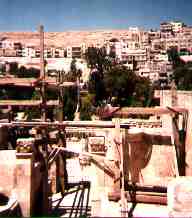 In the morning we rose late, took
breakfast and stepped out into the hot crowded street.
In the morning we rose late, took
breakfast and stepped out into the hot crowded street. 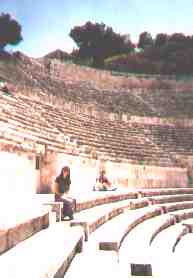 We turn right in front of the
King Hussein mosque and wander along the busy shopping street. The shops often look like
lock up garages. Things work differently here with small trinket shops residing next door
to a pottery workshop with a man sitting outside painting a freshly formed pot. Next door
there may be an open fronted cafe with a counter at the back and chairs and tables holding
men and backgammon boards. Next door a metal workshop with milling machines and a lathe.
People here seem friendly although we attract many stares. It could be the western
clothing or just my silly hat! We find a Roman Theatre and Odeon with views across to the
citadel. In the afternoon we spent some time organising a car and guide to take us round
the desert castles to the east of Amman. After accidentally missing the restaurant
district we walk back down town to a small cafe for a traditional meal consisting of a
number of small dishes with hummos, chick peas and lots of olive oil (2JD for 4). Walking
through the main square of downtown the population is 99% men with only the occasional
woman. There are many places to eat and an active market in well into the evening.
We turn right in front of the
King Hussein mosque and wander along the busy shopping street. The shops often look like
lock up garages. Things work differently here with small trinket shops residing next door
to a pottery workshop with a man sitting outside painting a freshly formed pot. Next door
there may be an open fronted cafe with a counter at the back and chairs and tables holding
men and backgammon boards. Next door a metal workshop with milling machines and a lathe.
People here seem friendly although we attract many stares. It could be the western
clothing or just my silly hat! We find a Roman Theatre and Odeon with views across to the
citadel. In the afternoon we spent some time organising a car and guide to take us round
the desert castles to the east of Amman. After accidentally missing the restaurant
district we walk back down town to a small cafe for a traditional meal consisting of a
number of small dishes with hummos, chick peas and lots of olive oil (2JD for 4). Walking
through the main square of downtown the population is 99% men with only the occasional
woman. There are many places to eat and an active market in well into the evening.
Tuesday 2/9/97. Desert Castles.
Up at 7, out at 8 and off with our guide Fadi Mahadd in a little Lada to an Uncompleted 8th century palace near the airport.
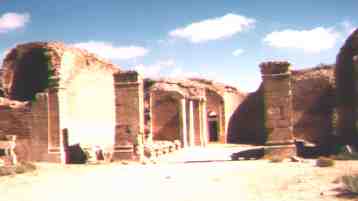 Qasr
Al-Mushatta Palace is one of many in the area that are often referred to as castles. This
one contains Persian and Roman influence in the design. Qasr
Al-Mushatta Palace is one of many in the area that are often referred to as castles. This
one contains Persian and Roman influence in the design. |
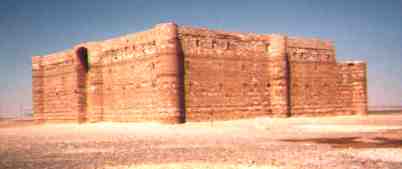 The
second castle, The
second castle, 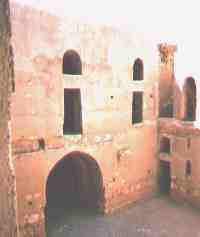 Qasr Al Harana, an 8th century AD Ummayad fort is further out into the
desert. Fadi described the castles as motels in the desert for camel trains. Qasr Al Harana, an 8th century AD Ummayad fort is further out into the
desert. Fadi described the castles as motels in the desert for camel trains. |
 Qasr Al Amra. Hunting lodge and baths. These appear much like the Roman baths
we find even in the UK. There is a well that collects rain water in the winter and a mule
driven winch to bring it back to the surface in the summer. Inside are murals that had
been blackened by Bedouin squatters who did not realise the historical importance of the
place. We were told that it was polite to give the guard 1JD for his trouble. Qasr Al Amra. Hunting lodge and baths. These appear much like the Roman baths
we find even in the UK. There is a well that collects rain water in the winter and a mule
driven winch to bring it back to the surface in the summer. Inside are murals that had
been blackened by Bedouin squatters who did not realise the historical importance of the
place. We were told that it was polite to give the guard 1JD for his trouble. |
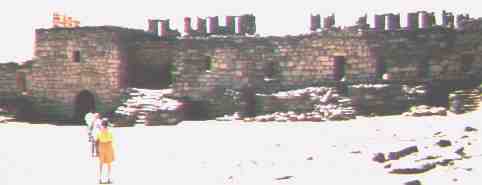 Qasr
Al Azrad. Built by the Romans, rebuilt by Arabs under Izz Ed Din Aybak during the crusades
and used by Lawrence of Arabia. Qasr
Al Azrad. Built by the Romans, rebuilt by Arabs under Izz Ed Din Aybak during the crusades
and used by Lawrence of Arabia. The desert consists of patches of grey and black rocks with red dust. There is little vegetation except for a small succulent plant. |
We took lunch of bread, salad (tomato & cucumber), hummos, mutabal (aubergine), lebalah (yogurt) at a nearby restaurant (4JD each) facing part of the 'Oasis'. Unfortunately all the water from the oasis is now pumped to Amman leaving it dry. Out in the desert we see many whirlwinds lifting columns of dust into the dry air above the flat plains. Back in Amman Fadi drove us through the posh area where the houses have gardens and are mostly complete. Then north over the tree covered hills to Jerash and on to Ajlun. When we arrived at our hotel (20JD per room) we paid Fadi the 60JD for the tour whereupon he asked for a further 12JD for petrol that apparently was not included in the 'all inclusive' price. Something to watch out for in future. Later on we found out that petrol here costs only 250fils (25p) per litre so we had been well ripped off. Another cheap dinner, 6JD for 4, of chicken, salad hummos and bread. The ATM here dishes out Dinar on demand, very handy.
Wednesday 3/9/97. Jerash.
On the road back to Jerash through the hills of striated white rock covered in olive
and date trees we pass occasional 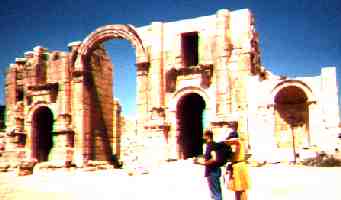 plant nurseries with local shrubs and
trees potted in olive oil drums. We can see Ajloun castle back over the rolling, sparsely
covered hills. Families build houses one floor at a time probably as finances permit.
Nowhere looks complete, everywhere a building site. The bus turns out to be a more
economic way to travel at 1.7JD for the four of us each way from Ajlun.
plant nurseries with local shrubs and
trees potted in olive oil drums. We can see Ajloun castle back over the rolling, sparsely
covered hills. Families build houses one floor at a time probably as finances permit.
Nowhere looks complete, everywhere a building site. The bus turns out to be a more
economic way to travel at 1.7JD for the four of us each way from Ajlun.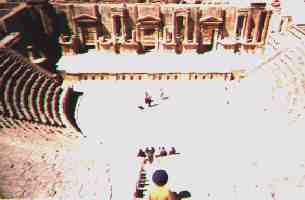
The Roman ruins of Jerash prove to be preserved in an excellent state with much
restoration in the past few decades. We hired a guide for 4JD but we kept him talking for
2.5 hours so we gave him 10 for his trouble. The best preserved building is the South
Theatre (as usual) which featured an almost complete stage and marvellous acoustics which
our guide delighted in demonstrating to us. 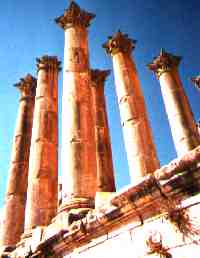 The Temple of Artemis is also in very
good condition with many of the pillars still standing. The guide demonstrated how the
columns wobble on their bases which can be felt by putting your finger in a crack. This
movement can be seen visibly on windy days, a feature that has kept them standing through
many earth quakes for more than one and a half thousand
The Temple of Artemis is also in very
good condition with many of the pillars still standing. The guide demonstrated how the
columns wobble on their bases which can be felt by putting your finger in a crack. This
movement can be seen visibly on windy days, a feature that has kept them standing through
many earth quakes for more than one and a half thousand 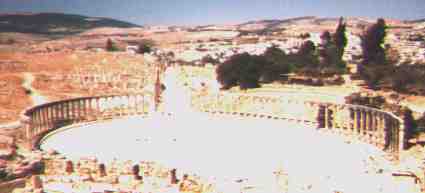 years.
years.
Back in Ajlun we made for the castle for a quick visit and to watch the sun go down. In the clear morning air you are supposed to be able to see into Syria, the west bank (Palestine) and Israel. We took a taxi back down the hill (500 fills (half a JD) each way) for a diet of falafel, shish kebab and of course hummos with lots of flat bread (6.400JD. There are 1000 fills to a Jordanian Dinar). The local music is an awful screechy, twangy, wailing mish mash. Most unpleasant to the ears.
Thursday 4/9/97. Omm Qays.
The daily breakfasts of flat bread, cheese, apricot jam and tea/coffee are getting
rather monotonous. Three busses to Umm Qais (or Om Keis) via Urbid (total 4JD for four).
The English spellings for town names seem to vary with each road sign we pass making
travelling a little difficult. Fortunately the locals and bus drivers seem able to
understand our amateur pronunciation. We stopped for lunch which we had picked up
previously from Ajlun. 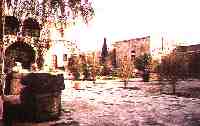 This time it was falafel (chickpeas, garlic and herbs rolled into balls and
fried) with a hummos dip. Our heavy diet of chickpeas is fermenting ferociously in the
heat with rather explosive results. The Roman ruins at Omm Qays are not so good. Most of
the buildings have been dismantled by the Byzantines and Ottomans to build other stone
dwellings. All that is left are some pillars from an Octagonal church and the obligatory
Theatre. This one is notable despite its poor condition due to the black basalt of which
it is built. The site guards, supervisor and Tourist Police are quite friendly if not
exactly hard working. We stopped for tea with them at the souvenir shop and bought a map
for an overpriced 4JD. It gets hotter here with each passing day. The locals say that it
is still quite cold but we are slowly expiring from the heat. The ruins are at the most
northern part of Jordan and from the hill you can see the Golan Heights and the sea of
Galilee across the valley in Israel. From the bus can be seen many tents of the Bedouin
people with sheep and goats wandering around. These are a few poles with tattered canvas
strung between. They must be fine in the summer but the Bedouin migrate south in the
winter.
This time it was falafel (chickpeas, garlic and herbs rolled into balls and
fried) with a hummos dip. Our heavy diet of chickpeas is fermenting ferociously in the
heat with rather explosive results. The Roman ruins at Omm Qays are not so good. Most of
the buildings have been dismantled by the Byzantines and Ottomans to build other stone
dwellings. All that is left are some pillars from an Octagonal church and the obligatory
Theatre. This one is notable despite its poor condition due to the black basalt of which
it is built. The site guards, supervisor and Tourist Police are quite friendly if not
exactly hard working. We stopped for tea with them at the souvenir shop and bought a map
for an overpriced 4JD. It gets hotter here with each passing day. The locals say that it
is still quite cold but we are slowly expiring from the heat. The ruins are at the most
northern part of Jordan and from the hill you can see the Golan Heights and the sea of
Galilee across the valley in Israel. From the bus can be seen many tents of the Bedouin
people with sheep and goats wandering around. These are a few poles with tattered canvas
strung between. They must be fine in the summer but the Bedouin migrate south in the
winter.
Friday 5/9/97. Travelling south.
Our hotel bill came to 170.2JD for the four of us but we were done on the bar bill
being charged 3JD per bottle of beer when they can be obtained down the road at 1JD
including a 100fills (0.1JD) returnable deposit. Another lesson learned; ask the price
first. Today will be a long day of travelling as we head south past Amman and on to Kerak.
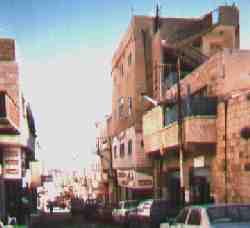 On the way we saw the Jordan river which is the one we have seen with actual
flowing water. Kerak is slightly better kept than Ajlun with pavements and trash
collection in the evening. The castle looks insignificant from the outside but inside
there is a labyrinth of rooms, corridors and stairways. A few of the vaulted rooms are
large enough to stable 20 horses comfortably. We are approached by an amiable man who
offers us rooms for the night at his hotel (11JD per room). He and his brother turn out to
also own a restaurant where we get a 20% discount on a menu without prices (!?). We ended
up talking to him about travelling to the dead sea the next day and he arranged a bus
driver to drop us off at the right place for only 3JD for the lot of us, much better than
the 25JD the taxi office offered. A late evening walk around the town provides interesting
sights, sounds and smells. The Egyptians seem to work harder than the Jordanians and we
see a carpet weaver at work where Alison and Kevin later purchase a carpet. Kevin found
out from him where he obtained his Egyptian dinner as it looks more appetising that our
recent diet.
On the way we saw the Jordan river which is the one we have seen with actual
flowing water. Kerak is slightly better kept than Ajlun with pavements and trash
collection in the evening. The castle looks insignificant from the outside but inside
there is a labyrinth of rooms, corridors and stairways. A few of the vaulted rooms are
large enough to stable 20 horses comfortably. We are approached by an amiable man who
offers us rooms for the night at his hotel (11JD per room). He and his brother turn out to
also own a restaurant where we get a 20% discount on a menu without prices (!?). We ended
up talking to him about travelling to the dead sea the next day and he arranged a bus
driver to drop us off at the right place for only 3JD for the lot of us, much better than
the 25JD the taxi office offered. A late evening walk around the town provides interesting
sights, sounds and smells. The Egyptians seem to work harder than the Jordanians and we
see a carpet weaver at work where Alison and Kevin later purchase a carpet. Kevin found
out from him where he obtained his Egyptian dinner as it looks more appetising that our
recent diet.
Saturday 6/9/97. The Dead Sea.
We met an English teacher on the bus who told us we had been overcharged for the bus
trip to the Dead Sea but we have arranged a special detour to take us to a good bit so we
are not bothered. The bus drives through a mountainous desert landscape of beige rocks and
dust down through a magnificent gorge 400 meters below sea level. It gets exceedingly hot
and the flies begin to become a nuisance. A few days ago we had heard that there was a
military checkpoint on the way but later people had then informed us that it was no
problem. We began getting worried when a soldier climbed on board and started checking
passports and dragged a Turkish man off the bus because he did not have the necessary
permissions. Fortunately the English teacher spoke up for us and when the soldier asked
him if he were our guide he said yes. The Turkish man was then let back on board and we
were set off on our way. We are dropped off by a small work site called 'Dead Sea
Products' and the driver pointed to the water. We did not see any of the shops or hotels
with fresh water showers that we had expected but when we approached the workers at the
site they kindly said that we could use their facilities (which turned out to be a hose).
Floating in the salt heavy sea was a weird experience. We felt like we were bobbing on top
of the water rather than swimming in it. Swimming turned out to be difficult as you could
not kick with your feet because they kept bobbing out of the water. If we had had a
newspaper we could have read it easily without fear of getting it wet. The downside is
that the stuff tastes foul and if it gets in your eyes it stings like mad. Cuts and
abrasions are also supposed to cause much pain but fortunately we had none of these. 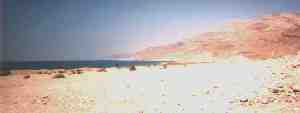 The
salt forms thick layers and on the banks this dries to form a crunchy sand but in the
water it stays like thick smooth mud. The others layered this mud onto their bodies for
the alleged healing properties but I abstained having had some of the water in my eyes and
not wanting to experience it again. The flies did not seem to like the water so we were
trouble free but they had nothing better to do in the shade of the trees than bother us so
we retreated to the air conditioned workmen's hut before getting out our lunch (figs,
bananas, meat roll and falafel). The workmen were very friendly and shared a little of our
lunch with us. About 1km walk up a baking dry and dusty road, a hitch in the back of a
pickup and then the bus to Kerak back through the canyon. If you changed the light beige
colour to red the view could be from Mars. The landscape looked like it was carved by
water creating cliffs, escarpments and land slides but now the water is gone. Apparently
they can get snow in the 4 month winter when they get their years supply of rain. We seem
to have an epidemic of Delhi Belly but that is to be expected considering the evident
hygiene methods. Kevin found the best cafe in town by asking the carpet weaver (from who
he bought a carpet) where he obtained his dinner. This turned out to be the best meal we
have had in Jordan since we arrived (Foul, rice, a type gezpacho soup and of course
bread). The call to prayer is unforgiving to weary travellers and Christian folk alike
when they start their un-melodic wailing at 4:30am.
The
salt forms thick layers and on the banks this dries to form a crunchy sand but in the
water it stays like thick smooth mud. The others layered this mud onto their bodies for
the alleged healing properties but I abstained having had some of the water in my eyes and
not wanting to experience it again. The flies did not seem to like the water so we were
trouble free but they had nothing better to do in the shade of the trees than bother us so
we retreated to the air conditioned workmen's hut before getting out our lunch (figs,
bananas, meat roll and falafel). The workmen were very friendly and shared a little of our
lunch with us. About 1km walk up a baking dry and dusty road, a hitch in the back of a
pickup and then the bus to Kerak back through the canyon. If you changed the light beige
colour to red the view could be from Mars. The landscape looked like it was carved by
water creating cliffs, escarpments and land slides but now the water is gone. Apparently
they can get snow in the 4 month winter when they get their years supply of rain. We seem
to have an epidemic of Delhi Belly but that is to be expected considering the evident
hygiene methods. Kevin found the best cafe in town by asking the carpet weaver (from who
he bought a carpet) where he obtained his dinner. This turned out to be the best meal we
have had in Jordan since we arrived (Foul, rice, a type gezpacho soup and of course
bread). The call to prayer is unforgiving to weary travellers and Christian folk alike
when they start their un-melodic wailing at 4:30am.
Sunday 7/9/97. Wadi Mussa.
Whenever we buy something the seller tries to make us pay double, triple or even ten
times the locals price. Sometimes we realise this especially when the price is marked on
the packet (e.g. Amstel beer is actually only 800fils per bottle, yoghurt 125fils). The
only exception is the busses who generally ask he same price as for the locals which is
evident as you can see the money changing hands. By 10am we were heading down the Kings
Highway to Al Tafila (2dinar). This area may not be classed as desert but it sure looks
like it. We pass through the Rift Valley where life on Earth is supposed to have started.
Right now it looks very unlikely in this dry, dusty and rocky environment. Perhaps the
climate has changed since then. The next bus also cost 2 Dinar but once we were in a
little town the locals told us that there were no busses to Shawbak and that a service
taxi would cost us 9 Dinar. We bargained the price down to 5 before starting the walking
away tactic. Once the word got around we were approached by two men in a pickup truck as
we were walking out of town who offered us a ride in the back for 1 Dinar.  We
saw this as a minor victory for tourists everywhere even though' we had to ride in the
back. This turned out to be fun as we were able to stand up and let the warm wind whistle
past our ears. Once in Shawbak (or Shaubak) we headed for a cafe in amongst a gaggle of
taxi drivers. Inside we ate the standard lunch, were hassled by the taxi drivers and
timeshared the toilet. Outside we were again hassled by taxi drivers offering us the short
trip to Wadi Mussa for an exorbitant 4 Dinar. We executed our best haggling tricks but
only managed to bring the price down to 3.5 until a shop keeper (he was the third person
we had met who had worked for the Jordanian embassy in South Kensington, London!) offered
to close his shop and take us for 1 Dinar. This incensed the taxi drivers who then caused
trouble for the shop keeper until he was forced to leave us behind. Not wanting to go back
to the taxis we walked up the road to a bus stop and waited for the bus that only half of
the locals told us existed. Ten minutes later the non-existent bus turned up and we were
on our way again. One of the passengers suggested the Messa Springs Hotel (22JD including
breakfast and dinner) was a good place to stay and then suggested the bus driver charge us
4JD for the ride. Fortunately the driver was happy with 2 so no more haggling was
required. The hotel turned out to be about the nicest place we have stayed so far with the
cleanest rooms, hot showers and good meals.
We
saw this as a minor victory for tourists everywhere even though' we had to ride in the
back. This turned out to be fun as we were able to stand up and let the warm wind whistle
past our ears. Once in Shawbak (or Shaubak) we headed for a cafe in amongst a gaggle of
taxi drivers. Inside we ate the standard lunch, were hassled by the taxi drivers and
timeshared the toilet. Outside we were again hassled by taxi drivers offering us the short
trip to Wadi Mussa for an exorbitant 4 Dinar. We executed our best haggling tricks but
only managed to bring the price down to 3.5 until a shop keeper (he was the third person
we had met who had worked for the Jordanian embassy in South Kensington, London!) offered
to close his shop and take us for 1 Dinar. This incensed the taxi drivers who then caused
trouble for the shop keeper until he was forced to leave us behind. Not wanting to go back
to the taxis we walked up the road to a bus stop and waited for the bus that only half of
the locals told us existed. Ten minutes later the non-existent bus turned up and we were
on our way again. One of the passengers suggested the Messa Springs Hotel (22JD including
breakfast and dinner) was a good place to stay and then suggested the bus driver charge us
4JD for the ride. Fortunately the driver was happy with 2 so no more haggling was
required. The hotel turned out to be about the nicest place we have stayed so far with the
cleanest rooms, hot showers and good meals.
Monday 8/9/97. To Petra.
 By 7:30 we were at the ticket booth and paying the extortionate 25JD for a 2
day pass (20JD for 1 day).
By 7:30 we were at the ticket booth and paying the extortionate 25JD for a 2
day pass (20JD for 1 day). 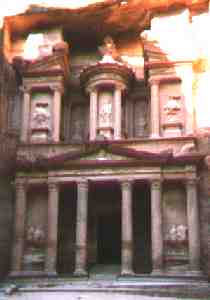 Petra is described as the rose red city but to the
Jordanian Department of Antiquities it is more like a gold mine. It would be nice if they
had spent some of the money on preservation and restoration but there is precious little
evidence of this. The walk down through the gorge is impressive especially when the
Treasury comes into view (featured in the film 'Indiana Jones and the last Crusade'). This
tomb turns out to be the best preserved 'building' that we see all day. Most all of the
features carved into the multicoloured sandstone have been worn almost away. The huge
facades often cover small chambers that almost always seem to be tombs. The Nabataeans
seemed to spend most of their time building tombs for the dead rather than abodes for the
living. A few of the larger tombs contained very large chambers up to 25 foot square and
sometimes with a couple of anti-chambers.
Petra is described as the rose red city but to the
Jordanian Department of Antiquities it is more like a gold mine. It would be nice if they
had spent some of the money on preservation and restoration but there is precious little
evidence of this. The walk down through the gorge is impressive especially when the
Treasury comes into view (featured in the film 'Indiana Jones and the last Crusade'). This
tomb turns out to be the best preserved 'building' that we see all day. Most all of the
features carved into the multicoloured sandstone have been worn almost away. The huge
facades often cover small chambers that almost always seem to be tombs. The Nabataeans
seemed to spend most of their time building tombs for the dead rather than abodes for the
living. A few of the larger tombs contained very large chambers up to 25 foot square and
sometimes with a couple of anti-chambers. 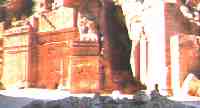 All of the chambers are featureless
inside and many are filled with sand and rubble. We followed a set of intriguing stone
steps that led up the side of the rock face behind a pair of closed wooden doors. The
stairs kept leading up and around the cliffs but we kept following them just to see what
was at the top. After a long and gruelling climb we find only a few small ruined buildings
at the top but the view was certainly worth the effort. On the way out we bargained rides
for the four of us on three camels back to the Treasury for 10JD. Unfortunately we were
cheated again as we were dropped off only half way there but as we are British we did not
complain.
All of the chambers are featureless
inside and many are filled with sand and rubble. We followed a set of intriguing stone
steps that led up the side of the rock face behind a pair of closed wooden doors. The
stairs kept leading up and around the cliffs but we kept following them just to see what
was at the top. After a long and gruelling climb we find only a few small ruined buildings
at the top but the view was certainly worth the effort. On the way out we bargained rides
for the four of us on three camels back to the Treasury for 10JD. Unfortunately we were
cheated again as we were dropped off only half way there but as we are British we did not
complain.
Tuesday 9/9/97. The hills of Petra.
For our second day in Petra we decided to see some of the more remote sites around the
ancient city. As this required extensive climbing we met fewer other visitors on the way.
There was not much left of the High Place of Sacrifice or the Crusader Castle but the
views were excellent. Down the other side of the mountain the Lion Monument fountain was a
faded lion without a head.  The Garden Triclinium and the tomb of the Roman
Soldier are used as stables for donkeys as are many of the old tombs. Even here the tombs
are built to pretty much the same design with only the sizes different. We found what we
assumed were dwellings as they are simple square caves also without decoration. The
Bedouin probably now use these ancient dwellings to camp in overnight but there is little
signs of habitation. We visited the new museum which is small but good before heading up
to the El Deir (Monastery) which looks rather like a larger version of the Treasury.
The Garden Triclinium and the tomb of the Roman
Soldier are used as stables for donkeys as are many of the old tombs. Even here the tombs
are built to pretty much the same design with only the sizes different. We found what we
assumed were dwellings as they are simple square caves also without decoration. The
Bedouin probably now use these ancient dwellings to camp in overnight but there is little
signs of habitation. We visited the new museum which is small but good before heading up
to the El Deir (Monastery) which looks rather like a larger version of the Treasury. 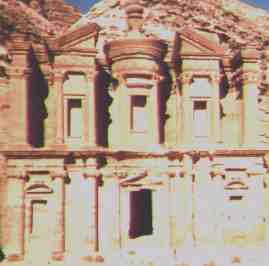 It seems like the Nabateans saw a fancy Roman building from the outside,
liked it and tried to copy it. The only problem was that they did not know the scale or
the purpose of the structure and so when they put in the windows they missed out the rooms
that are supposed to go behind. They also seemed to spend an inordinate amount of time
building tombs for their dead and forgetting to create nice places to live. The tombs had
to be just like the Abdulah's (read Jone's) down the road only bigger. Mind you the whole
wealth and economy of Petra was built on robbing the trade caravans that went past the
area carrying spices and incense etc. north from Arabia. Later on they got civilised and
called it taxes but it was still just a protection racket. Some time after the Romans took
over an emperor set up trade routes via the Red Sea so the Nabateans had no one to bully
and rather than do some work for a change they let the whole place fall into ruin. Now the
place is inhabited by Bedouin who have found an easy life trying to cheat tourists out of
a couple of Dinar (e.g. 1.5JD for a bottle of water that is labelled 0.290) so in a way
nothing has changed except for the value of the pickings. We have noticed so far that the
Jordanians are allergic to work and if anything at all gets done it is done by the
Egyptians.
It seems like the Nabateans saw a fancy Roman building from the outside,
liked it and tried to copy it. The only problem was that they did not know the scale or
the purpose of the structure and so when they put in the windows they missed out the rooms
that are supposed to go behind. They also seemed to spend an inordinate amount of time
building tombs for their dead and forgetting to create nice places to live. The tombs had
to be just like the Abdulah's (read Jone's) down the road only bigger. Mind you the whole
wealth and economy of Petra was built on robbing the trade caravans that went past the
area carrying spices and incense etc. north from Arabia. Later on they got civilised and
called it taxes but it was still just a protection racket. Some time after the Romans took
over an emperor set up trade routes via the Red Sea so the Nabateans had no one to bully
and rather than do some work for a change they let the whole place fall into ruin. Now the
place is inhabited by Bedouin who have found an easy life trying to cheat tourists out of
a couple of Dinar (e.g. 1.5JD for a bottle of water that is labelled 0.290) so in a way
nothing has changed except for the value of the pickings. We have noticed so far that the
Jordanians are allergic to work and if anything at all gets done it is done by the
Egyptians.
We were up in time for the 08:00 bus to Aqaba but we hopped of at the Wadi Rum turning
and waited for the inevitable offers of a lift. Ten minutes later we were in the back of a
pickup truck for an extortionate 4 Dinar for the 29km trip. When we arrived at Rum the
driver asked for another Dinar over the bargained price but as you can imagine we refused.
The first building in Rum is the Government Rest House where we were asked to pay 1 Dinar
each just to enter Wadi Rum. The village turned out to be just the Rest House and about
100 breeze block built shacks. Most all of the houses seem to have one or more camels in
their gardens, walled with yet more breeze blocks.  The Rest House
has prices for camel and Jeep (Toyota) trips into the desert but the locals say they can
undercut them. When we went to haggle out a deal with the locals we found that their
prices were just the same as the governments and all our haggling tricks did not work so
we went for lunch. Whilst eating we were approached again and eventually succumbed to a
trip in a Jeep to Khazali (15JD) and by camel to the Spring of Lawrence (5JD each). The
'Jeep' took us via the Spring of Lawrence which turned out to be quite close to the
village. The Bedouin overnight tent sits at the base of the rocks fallen from the mountain
and the spring starts half way up marked by an increase in vegetation and a tree. There is
no sign of the spring from the surface except for a pipe leading from the top to a
concrete cistern by the tent. The tent is full of sleepy looking tourists perhaps with
nothing else to do so we are pleased that we decided not to stay the night there. About
the same distance on again is the Khazali which is a small canyon on the other side of a
stretch of desert to the Spring of Lawrence.
The Rest House
has prices for camel and Jeep (Toyota) trips into the desert but the locals say they can
undercut them. When we went to haggle out a deal with the locals we found that their
prices were just the same as the governments and all our haggling tricks did not work so
we went for lunch. Whilst eating we were approached again and eventually succumbed to a
trip in a Jeep to Khazali (15JD) and by camel to the Spring of Lawrence (5JD each). The
'Jeep' took us via the Spring of Lawrence which turned out to be quite close to the
village. The Bedouin overnight tent sits at the base of the rocks fallen from the mountain
and the spring starts half way up marked by an increase in vegetation and a tree. There is
no sign of the spring from the surface except for a pipe leading from the top to a
concrete cistern by the tent. The tent is full of sleepy looking tourists perhaps with
nothing else to do so we are pleased that we decided not to stay the night there. About
the same distance on again is the Khazali which is a small canyon on the other side of a
stretch of desert to the Spring of Lawrence. 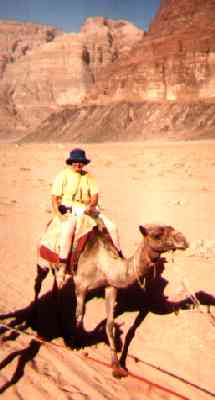 The canyon walls
have a few samples of rock art. We put off the camel ride till 16:00 so that we can ride
in the cooler afternoon. The camels seem more docile than their reputation which was just
as well as 3 small children were assigned to guide us.
The canyon walls
have a few samples of rock art. We put off the camel ride till 16:00 so that we can ride
in the cooler afternoon. The camels seem more docile than their reputation which was just
as well as 3 small children were assigned to guide us. 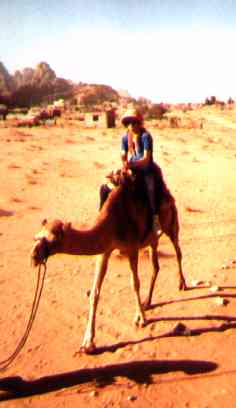 The
desert scenery is as spectacular as we were led to believe with the blue sky contrasting
sharply with the red and beige sandstone mountains and merging with the red sand of the
desert. Parts of the desert were also dotted with tufts of vegetation that shone green
against the red sand. The camels made some odd noises when they did not want to do
something. It can best be described as sounding like a lion roaring under water. They
generally did not want to sit down when asked and if you were getting on they would get up
as soon as you had touched the saddle so you had to be quick. The sun was setting as we
plodded back to Rum casting an orangey red glow onto the surrounding rocks. The last dying
rays of the sun cut shafts of light through the dusty desert air. We chose to sleep on the
roof of the Rest House this night (1JD each), more out of curiosity than necessity. As
compensation for this self imposed hardship we awarded ourselves a bottle of overpriced
beer each. Sleeping on the roof under the stars turned out to be not half that bad. Stored
heat from the rooftop kept us warm and there were only a few mosquitoes. Even with the
sparse street lighting in Rum and a half crescent moon we could still see more stars in
the cloudless desert night than from anywhere in England. Later when the moon had gone
down I counted two shooting stars and a satellite travelling south to north twice. In the
early morning I heard what may have been something like a desert fox.
The
desert scenery is as spectacular as we were led to believe with the blue sky contrasting
sharply with the red and beige sandstone mountains and merging with the red sand of the
desert. Parts of the desert were also dotted with tufts of vegetation that shone green
against the red sand. The camels made some odd noises when they did not want to do
something. It can best be described as sounding like a lion roaring under water. They
generally did not want to sit down when asked and if you were getting on they would get up
as soon as you had touched the saddle so you had to be quick. The sun was setting as we
plodded back to Rum casting an orangey red glow onto the surrounding rocks. The last dying
rays of the sun cut shafts of light through the dusty desert air. We chose to sleep on the
roof of the Rest House this night (1JD each), more out of curiosity than necessity. As
compensation for this self imposed hardship we awarded ourselves a bottle of overpriced
beer each. Sleeping on the roof under the stars turned out to be not half that bad. Stored
heat from the rooftop kept us warm and there were only a few mosquitoes. Even with the
sparse street lighting in Rum and a half crescent moon we could still see more stars in
the cloudless desert night than from anywhere in England. Later when the moon had gone
down I counted two shooting stars and a satellite travelling south to north twice. In the
early morning I heard what may have been something like a desert fox.
Thursday 11/9/97. A lazy day in Aqaba.
At 06:10 other peoples alarm bells started ringing and we were up by 6:30 to get ready
for the bus to Aqaba.  As we sat on the bench outside the Rest House the sun
began to rise over the mountains and cast its warming glow on the opposite rocks.
As we sat on the bench outside the Rest House the sun
began to rise over the mountains and cast its warming glow on the opposite rocks. 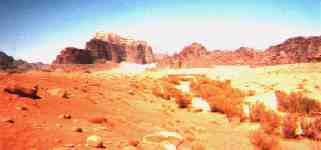 The desert landscape was breathtaking all over again as we drove
out of the valley and the lower hills rolled off in shades of grey towards the sun. Aqaba
is Jordan's only sea port which makes it popular not only with sun seekers but also trucks
and cargo ships which can be seen in abundance as we head down to the town from the hills.
It being our last stop in Jordan we decide to go for a posh hotel and end up at the 25JD
per night for a room at the 'Al Shuala Hotel'. On the way we are stopped by a barber who
invites us in for tea. He describes himself as an 'International Barber' but this turns
out to be because he invites every passing tourist in for tea and receives many postcards
from around the world that he then pastes into his shop window. Anyway, the 'special'
cinnamon tea is good. Next stop is the JETT bus office to book the late Sunday bus back to
Amman. JETT (Jordan Express Tourist Travel) is the easy but more expensive way for
tourists to get around and you have to book ahead. We find the beach is rather male
dominated and full of people wanting to sell umbrellas, tea and glass bottomed boat trips.
Un-perturbed we go for a swim anyway but the sellers and the oglers do not make it
comfortable. A few local girls go for a swim but because of the religious laws they have
to go in fully clothed, even down to the shoes. A couple of older ladies went in dressed
in their full length black 'tents' complete with head scarf. It seems to be hotter here
than out in the desert at Wadi Rum. Even at night it does not seem to cool down
appreciably. For dinner we finally manage to taste the mansaff dish of lamb slowly cooked
in a blend of yoghurt and goats milk served on a bed of rice. To round it off we also try
the long awaited deserts. These turn out to be not all as scrumptious as we first
supposed. The first was a flat slab of what tasted like goats cheese with a syrup soaked
crumbly biscuit topping. The second was a kind of cheesy cream bar wrapped in a shredded
wheat and the last and best was a nutty, biscuity confection. All this followed by Arabic
coffee made for a good meal especially as we shared two portions between four at 10JD the
lot. The hotel does not allow alcohol onto the premises so we risk a public flogging by
smuggling in four bottles of beer to drink on our third floor balcony. From there we
overlook the harbour and Elat in Israel on the far shore. They must have heard that we
were in town as they put on a fireworks display.
The desert landscape was breathtaking all over again as we drove
out of the valley and the lower hills rolled off in shades of grey towards the sun. Aqaba
is Jordan's only sea port which makes it popular not only with sun seekers but also trucks
and cargo ships which can be seen in abundance as we head down to the town from the hills.
It being our last stop in Jordan we decide to go for a posh hotel and end up at the 25JD
per night for a room at the 'Al Shuala Hotel'. On the way we are stopped by a barber who
invites us in for tea. He describes himself as an 'International Barber' but this turns
out to be because he invites every passing tourist in for tea and receives many postcards
from around the world that he then pastes into his shop window. Anyway, the 'special'
cinnamon tea is good. Next stop is the JETT bus office to book the late Sunday bus back to
Amman. JETT (Jordan Express Tourist Travel) is the easy but more expensive way for
tourists to get around and you have to book ahead. We find the beach is rather male
dominated and full of people wanting to sell umbrellas, tea and glass bottomed boat trips.
Un-perturbed we go for a swim anyway but the sellers and the oglers do not make it
comfortable. A few local girls go for a swim but because of the religious laws they have
to go in fully clothed, even down to the shoes. A couple of older ladies went in dressed
in their full length black 'tents' complete with head scarf. It seems to be hotter here
than out in the desert at Wadi Rum. Even at night it does not seem to cool down
appreciably. For dinner we finally manage to taste the mansaff dish of lamb slowly cooked
in a blend of yoghurt and goats milk served on a bed of rice. To round it off we also try
the long awaited deserts. These turn out to be not all as scrumptious as we first
supposed. The first was a flat slab of what tasted like goats cheese with a syrup soaked
crumbly biscuit topping. The second was a kind of cheesy cream bar wrapped in a shredded
wheat and the last and best was a nutty, biscuity confection. All this followed by Arabic
coffee made for a good meal especially as we shared two portions between four at 10JD the
lot. The hotel does not allow alcohol onto the premises so we risk a public flogging by
smuggling in four bottles of beer to drink on our third floor balcony. From there we
overlook the harbour and Elat in Israel on the far shore. They must have heard that we
were in town as they put on a fireworks display.
Friday 12/9/97. A day on the beach.
Having found the naff beach in Aqaba we took the advice of a glass bottomed boat
captain and searched out the sectioned off hotel beach for tourists. The concierge at our
hotel said we needed a beach pass to get into it but the captain told us we could get to
the same beach free via the Aquamarina Hotel which we found to be true. This beach turned
out to be more like the beaches we know and love with mixed occupancy and no one swimming
in tents. Best of all there was no one trying to sell us stewed tea or trips on boats. We
found a parasol and loungers for free and were soon soaking up the sun and taking dips to
cool off. Later on we each took a ride in a rubber ring strung to the back of a speed
boat. This turns out to be easier and more fun than trying to water ski. On the way back
from the beach we heard what sounded like machine gun fire but no one else seemed to take
any notice. The concierge at the hotel told me there was no trouble in Jordan and
suggested that it was not gun file that we heard but later on the owner of a deli 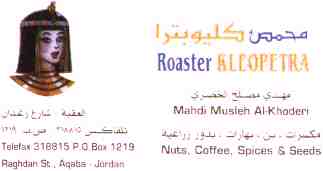 down the
road said that guns are often fired to celebrate weddings. I've heard of shotgun weddings
but that's taking it a bit far. A fruit juice bar received our patronage every day of our
visit to Aqaba and this day is no exception. Today we tried his falafel sandwiches which
turned out to be quite filling so we reduced our evening meal to deserts at 'Hani Ali'
where we ate the night before. This was followed by more elicit beer smuggled into our
hotel room and consumed on the balcony overlooking the Red Sea. The deli owner turned out
to offer that good old Jordanian hospitality that we had heard so much about. We only went
in his shop to look for a snack and ended up spending about an hour tasting teas, coffee,
Jordanian delight (read: Turkish delight) and nuts. Not surprisingly we found ourselves
buying much of the same to take home.
down the
road said that guns are often fired to celebrate weddings. I've heard of shotgun weddings
but that's taking it a bit far. A fruit juice bar received our patronage every day of our
visit to Aqaba and this day is no exception. Today we tried his falafel sandwiches which
turned out to be quite filling so we reduced our evening meal to deserts at 'Hani Ali'
where we ate the night before. This was followed by more elicit beer smuggled into our
hotel room and consumed on the balcony overlooking the Red Sea. The deli owner turned out
to offer that good old Jordanian hospitality that we had heard so much about. We only went
in his shop to look for a snack and ended up spending about an hour tasting teas, coffee,
Jordanian delight (read: Turkish delight) and nuts. Not surprisingly we found ourselves
buying much of the same to take home.
Saturday 13/9/97. Boat trip.
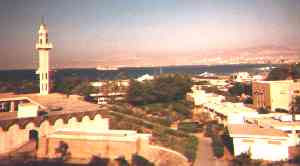 Having booked a boat trip from the hotel the night before we were
up at the early hour of 10am to meet the captain (as he liked to be known) and were soon
bobbing across the ocean (or sea) waves to some coral reefs further along the coast. The
boat had a glass bottom through which the sea bed and sea life could be seen quite clearly
as, could all the junk that had also found its way down there. On the way the crew (of
one) reeled out a fishing line with two plastic squid attached to the end. After about
half an hour he started jumping up and down in excitement as on the end a small tuna fish
(or that's what they called it) had become ensnared. After leaving it on the deck of the
boat to thrash about for a while they took Kevin's suggestion to put it out of its misery
by hitting it on the head. This the captain did with a pair of pliers as nothing else
suitable came to hand. This being the only stretch of coastline that Jordan has we passed
many cargo ships being either loaded with what we assumed was potash or unloaded with
containers. The captain tried to anchor us in the reef but ended up loosing his anchor so
we spent some time finding it again before beaching the boat and swimming from there.
There were quite a few varieties of coral and fish in a reef quite close to the surface so
we spent quite a few hours through the rest of the day exploring them and trying to avoid
the sea anemones which Kevin said could give a bad sting. Lunch, strangely enough, came in
the form of barbecued fish, salad and bread with grapes and sweet tea to follow. From our
view point under a permanent steel canopy on the beach in Jordan we were able to see the
Red Sea coastlines of Egypt, Israel and Saudi Arabia. An interesting thought even though
the distinctions were far from apparent. To complete a fishy day we ate Red Snapper at the
'Captain's Restaurant' (not our captain of the day) and smuggled our usual bottles of beer
back into the hotel.
Having booked a boat trip from the hotel the night before we were
up at the early hour of 10am to meet the captain (as he liked to be known) and were soon
bobbing across the ocean (or sea) waves to some coral reefs further along the coast. The
boat had a glass bottom through which the sea bed and sea life could be seen quite clearly
as, could all the junk that had also found its way down there. On the way the crew (of
one) reeled out a fishing line with two plastic squid attached to the end. After about
half an hour he started jumping up and down in excitement as on the end a small tuna fish
(or that's what they called it) had become ensnared. After leaving it on the deck of the
boat to thrash about for a while they took Kevin's suggestion to put it out of its misery
by hitting it on the head. This the captain did with a pair of pliers as nothing else
suitable came to hand. This being the only stretch of coastline that Jordan has we passed
many cargo ships being either loaded with what we assumed was potash or unloaded with
containers. The captain tried to anchor us in the reef but ended up loosing his anchor so
we spent some time finding it again before beaching the boat and swimming from there.
There were quite a few varieties of coral and fish in a reef quite close to the surface so
we spent quite a few hours through the rest of the day exploring them and trying to avoid
the sea anemones which Kevin said could give a bad sting. Lunch, strangely enough, came in
the form of barbecued fish, salad and bread with grapes and sweet tea to follow. From our
view point under a permanent steel canopy on the beach in Jordan we were able to see the
Red Sea coastlines of Egypt, Israel and Saudi Arabia. An interesting thought even though
the distinctions were far from apparent. To complete a fishy day we ate Red Snapper at the
'Captain's Restaurant' (not our captain of the day) and smuggled our usual bottles of beer
back into the hotel.
Sunday 14/9/97. Last day.
As usual with last days anywhere we all got a little fidgety with nothing specific to do other than pack and wait for our bus to Amman. Fortunately we had all left our shopping till this day and after visiting the man in the deli to sample his teas, coffee and Jordanian delight before buying more, we spent a few more happy hours browsing through the shops trying to find a place with interesting things to buy where they were also less likely to rip us off. At last we found an Israeli man who told us more palpable truths on a number of items about which we had been misled up until then. We ended up buying all our momentoes from him. There is practically nothing made in Jordan that is worth buying so what we did buy was made in India and Italy ! Following a last visit to our favourite juice shop for a fruit cocktail juice, falafel sandwich and a complimentary tea we headed for the JETT bus stop and on to Amman. When we arrived we were surrounded by taxi drivers trying to convince us that there were no more busses to the airport and that they could do a 'special deal' and take us for 25JD. None of them would tell us the way to the bus station so we had to ask a shop keeper. It was only about a 1km walk away and when we got there there was a huge sign advertising the 24 hour bus service to the airport. We were spoilt for choice on bus departure times and ended up eating at the nearby Mirage Hotel before taking the midnight bus to Queen Alia Airport. Our flight was not until 06:15 so we kipped down in a quiet corner on the stone floor until 04:00 when we went to check in.
This sadly ends our trip to Jordan and although there is not much to draw us there again we all had a good time and will probably visit similar places in the future.
| Travelogues by Malcolm Weller |  |